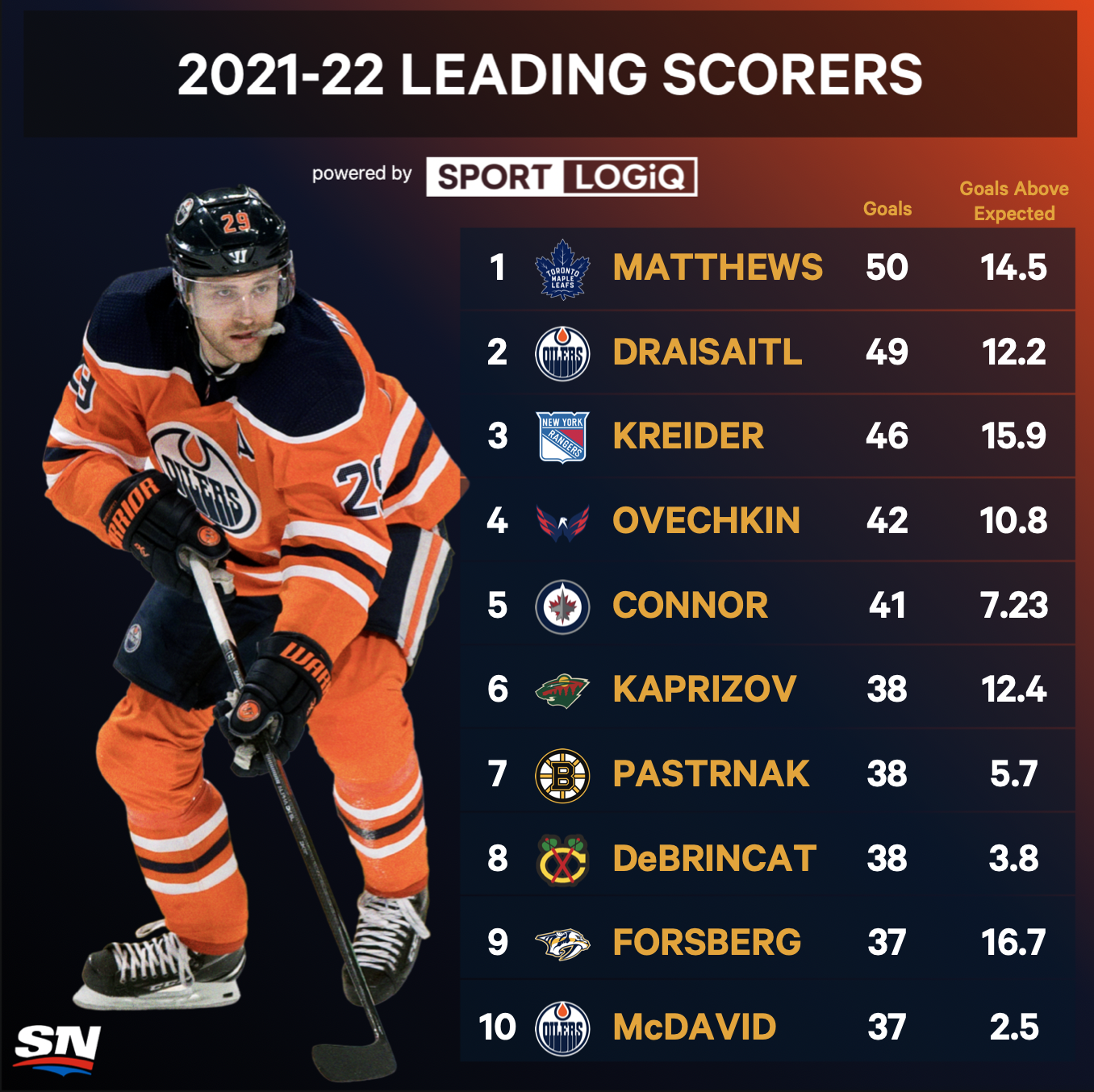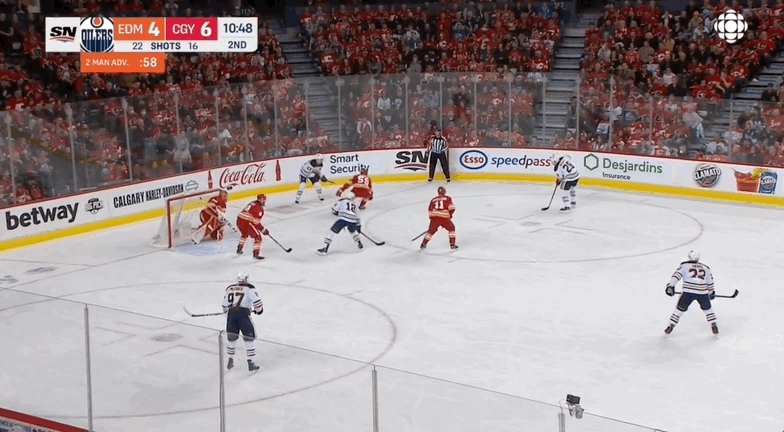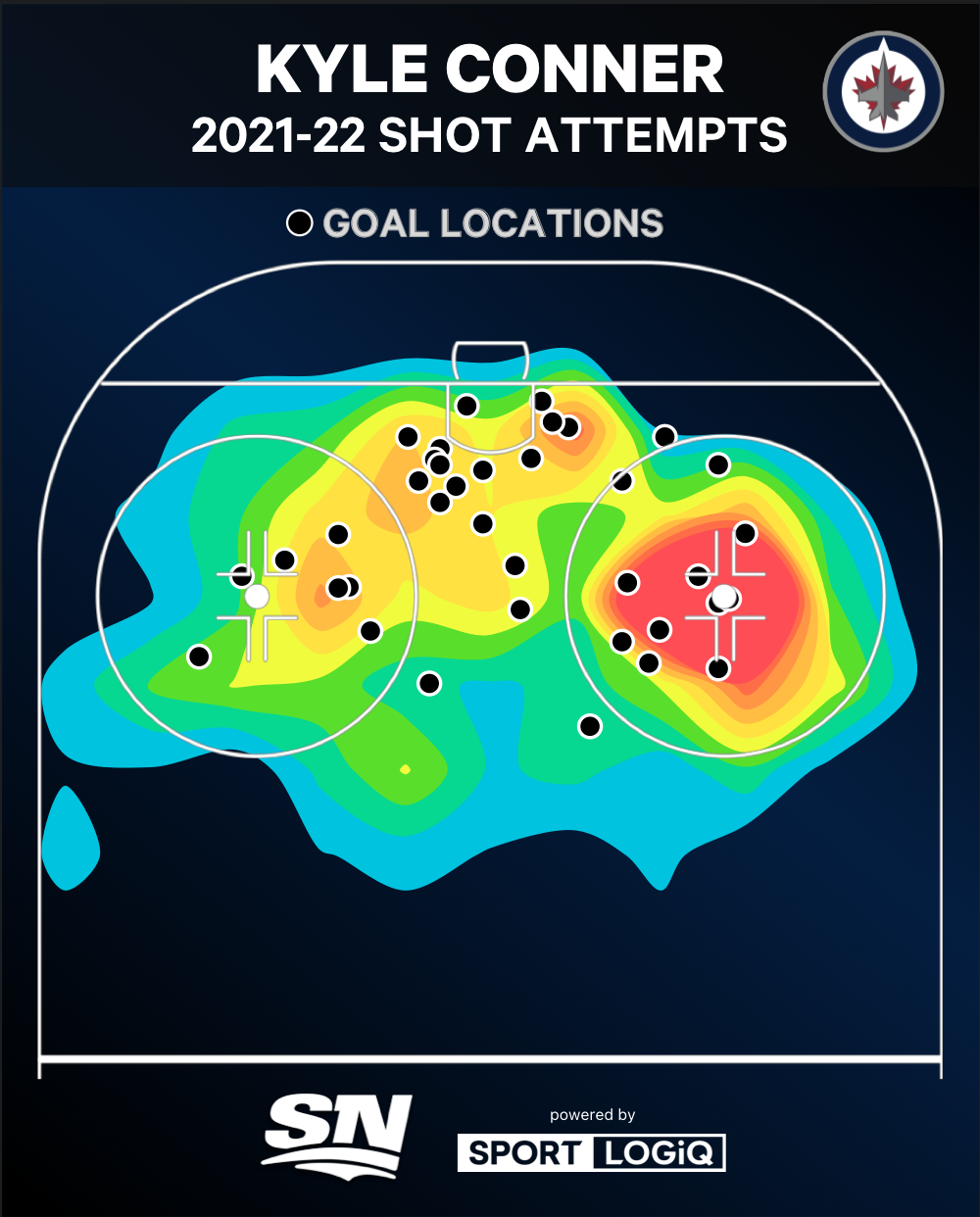With an empty-net goal against the Winnipeg Jets last night, Auston Matthews became the first player to hit the 50-goal mark this season. The Maple Leafs’ centre was the leading scorer last season as well, with 41 tallies in a condensed 52-game season. Had the year extended to the full length of 82 games, he likely would have shattered that milestone last year as well.
In 2019-20, which was also shortened (though to varying lengths around the 70-game mark), three forwards game close to that milestone: Alex Ovechkin (48), David Pastrnak (48), and Matthews (47).
Rewind to the last complete season in 2018-19, there were two players to net at least 50 — Ovechkin and Draisaitl.
This year, there will likely be more than two forwards to hit that mark. Matthews is there, Draisaitl is one away, and Kreider’s just four shy. There haven’t been three players to hit this marker in a single season since 2009-10.
But Ovechkin and Kyle Connor aren’t far off, either. There could be five 50-goal scorers by season’s ends, something that hasn’t been seen since 2005-06.
With so many skillful goal scorers thriving this season, who will finish on top at the end of the year and win the Rocket Richard?
Let’s take a closer look.
With 50 goals in 62 games, Matthews is on pace to score 62 goals in 77 games. He’d be the first forward to net 60 since Steven Stamkos back in 2011-12. Even though he’s missed time, he’s at the top in raw numbers and when factoring in ice time. Along with the best goals rate, his expected goal generation is at the top of the league as well.

We’ve analyzed whether the forward’s scoring is sustainable quite a few times this season, and there are encouraging signs. There’s his shot volume — 23.3 attempts that rank sixth in the league in all situations — and quality, with over 59 per cent coming from the slot. No one shoots from that area of the ice at a high rate than Matthews’ 13.8 attempts per 60. As concentrated as his shots are to the home plate in front of the crease, it’s not all coming from the same spot either. So there’s a bit less predictability on where he’ll shoot from.

No one creates scoring chances off the cycle at a higher rate than the Maple Leafs’ forward, plus he can generate quality looks off the rush. Then there’s the versatility aspect of his game; he can beat goaltenders with every single shot and can mix it up to challenge opponents and keep them guessing on which skill he’ll use from his toolbox.
What betters his chances of scoring is the pre-shot movement. Mitch Marner’s primary passes have directly preceded about 27 per cent of Matthews’ shot attempts. No one’s better at moving the puck to the slot than the winger, and that just adds another element of danger.

Between his shot quality and what comes before his attempts, Matthews’ expected goal total is 35.5. Before accounting for shooting talent, that would pace out to 44 goals across a full season which he’s already surpassed. Despite scoring above expectations, it doesn’t appear that his scoring is suddenly going to dry up. His finishing ability, on top of such a strong base of offensive generation, may be what keeps him in the league lead.
If Draisaitl’s 49 goals aren’t impressive enough, the forward’s assist totals are one short of matching that number. So he has a legitimate chance at two trophies at season’s end: the Rocket Richard and the Art Ross.
But let’s focus on the former.
Draisaitl’s shot creation culminates to an expected goal value of 36.8 which leads the league. Like Matthews, he’s already surpassed the 82-game pace it’s put him on. But the gap between the value of his shot generation and finishing ability is less than the other two players he’s between in the race.

However, when factoring in minutes played, his xG generate and scoring are both are slightly slower paces than Matthews and Kreider, too. That could become a factor down the stretch.
A key difference between Draisaitl and the centre ahead of him goal scoring is his shooting. The Oilers’ forward doesn’t shoot the puck at nearly the same rate. In fact, his all situation shot attempt rate of 16.2 per 60 ranks 79th in the league. And it’s not as if a ridiculously high percentage of those shots are concentrated to the slot to make up for it comparatively.

Most of Draisaitl’s shots come from the right side of the ice. That gives the lefty a great angle to shoot from, though — and it opens him up for one-timers that are particularly dangerous on the power play from him, where he’s already net 20 goals. What benefits him as well is who tends to set him up most. About 35 precent of his shot attempts are set up by a shot from Connor McDavid, one of the quickest and most evasive forwards in the league. As defenders watch him fly around the ice with the puck on his stick, his teammate has time and space to get in shooting position. Since he’s shown the propensity to fire it quickly after a pass, it stuns goaltenders. And that’s what helps raise that expected goal generation despite not shooting at as high of a pace.

A few months back when we last analyzed the Rocket Race, it was Kreider narrowly in the lead. Now he’s back in third, but still keeping pace. Of the three skaters, he was the least expected to reach these heights. Before this season, his previous highs all were below 30.
Unlike Matthews, Kreider tends to cluster most of his shots to one area of the ice. That area is directly in front of the goal crease.

That’s where he’s stationed on the power play, tipping and re-directing shots past the goaltenders for a league-leading 24 goals on the advantage. He’s one of the best in all situation deflections, and second on the power play with 7.14 attempts per 60 that connect on goal 75 per cent of the time. And no one finishes that shot type better than him. What sets him up for re-direct opportunities so often is the Rangers’ high-volume power play that sets him up to do his magic.
So what Kreider lacks in volume, he can make up in quality with about 56 per cent of his shots coming from the slot in all situations, and a league-leading rate of shots from the inner slot.
When those shots aren’t coming from his net-front play, the speedy winger can drive up the ice with the puck to reach those high-danger areas. So there’s versatility in his offensive generation.
What also helps is his primary linemate, Mika Zibanejad, is also expected to shoot. This year at 5-on-5, however, his goals rate is lower than years past. The centre’s had some nifty set ups (with primary shot assists on 30 per cent of Kreider’s attempts), whether with his passing at even strength or shooting on the power play that Kreider’s tipped in. But there is a difference between him as the scorer’s primary helper compared to Marner and McDavid.
With all that in mind, Kreider’s scoring the most goals above expected of the top-three. Maybe that puts a damper on his chances to reach the 55 he’s on pace for, which is behind what Draisaitl and Matthews are on track for. His scoring rate, however, is ahead of the former’s as is his expected goal generation — that works in his favor, seeing as the two have the same number of games remaining. But can his finishing ability push him ahead?
It’s going to be tough for anyone to make up the difference and jump ahead of Matthews, Draisaitl, or Kreider. But two players aren’t too far behind that there’s always a chance.
One of them’s Ovechkin, whose one of the greatest goal scorers of all time that you can’t ever fully count out.
The 36 year old got off to an outstanding start this season on the score sheet, even without his one-timer delivering up to expectations. But his scoring did slow down. Now he’s up to 42 goals in 66 games that put him on pace for 51 across a full season (which for him, at most, will be 80 games). That’s a few back from the pace he was on in late January. Still, this could be his first time back to that milestone since 2018-19 and his ninth time reaching the 50-goal mark.
Few players shoot as frequently as Ovechkin’s 26.1 attempts per 60 in all situations. Only Nikolaj Ehlers and David Pastnrak do at a higher clip. But the location of those shots is important to note. Under 43 per cent of his shots come from the slot, even though he’s had a lot of success scoring from in close this season. Rather, so many of his shots are concentrated to ‘his office’ in the left circle, or further outside. Everyone knows how effective he can be from there, but shooting from further out can give defenders a better chance to block those attempts or he can miss. Only 49 per cent of his shots actually connect on goal.

The keys to Ovechkin’s success are shot volume and finishing ability. And in most seasons, that gets him very far. But this year, it may not be coming at a frequent enough pace to overcome the skaters ahead of him.
Kyle Connor
Rounding out the skaters with at least 40 goals this season is Connor of Winnipeg. While Ovechkin leans to the left circle, the Jets’ winger shoots from the right quite a bit as highlighted in red below.

The quality of his shots combine for an expected goal total of 33.8. That’s good for fifth in the league, behind Draisaitl, Matthews, McDavid, and Alex DeBrincat. It’s also only 7.23 above expectations, which is a smaller gap than the four leaders. But when accounting for ice time, his expected goal rate slides back behind the three leading scorers and only moves ahead of Ovechkin’s. His actual goal rate pushes him even further; it actually ranks 20th in the league among forwards while all four of the aforementioned stars are in the top-10.
Right now, he’s on pace to score 49 goals and just fall shy of the 50-goal mark. And there’s a very good chance, considering his offensive generation and shooting talent, that he reaches, or even slightly exceeds that. But the Jets have one game remaining fewer than the Capitals, Rangers, and Oilers, and two less than the Maple Leafs. And Connor’s pace is already behind the rest. So he’s in good company, but probably won’t find himself at the top this year.



 4:46
4:46

